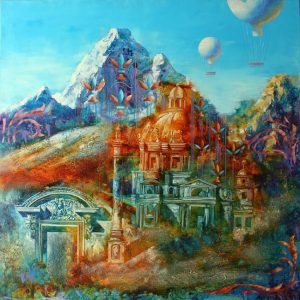charopevec
“Lady with an Ermine” by Leonardo da Vinci, or Oda Painting
 The world, according to Leonardo, is known through the senses, and the eye is the master of the senses, therefore painting is the queen of art. Such reasoning is evidence of the deep conviction of a brilliant painter in the greatness and omnipotence of his art.
The world, according to Leonardo, is known through the senses, and the eye is the master of the senses, therefore painting is the queen of art. Such reasoning is evidence of the deep conviction of a brilliant painter in the greatness and omnipotence of his art.
“The Lady with an Ermine” is the second (after the “Portrait of a Musician”) experience of Leonardo da Vinci in portrait genre. In 1800, in Italy, Prince Adam Jerzy Czartoryski, son of Princess Elzbety Dorota Flemming Czartoryski (Izabella (Elżbieta) Dorota Fleming), bought this portrait for his mother, who in 1801 opened the first public museum in Pulawy in Poland. Continue reading
Jazefa Mehofffer’s “Wonderful Garden”
 The picture is filled with the sun, full of bright colors of the summer, with joy and carelessness, it’s hard to tear your eyes: the longer you look, the more you want to be next to the characters among the lush greenery and flowers, and even more so – to hide under the shade of trees and watch a giant grandmother.
The picture is filled with the sun, full of bright colors of the summer, with joy and carelessness, it’s hard to tear your eyes: the longer you look, the more you want to be next to the characters among the lush greenery and flowers, and even more so – to hide under the shade of trees and watch a giant grandmother.
“Dzywny ogród” by Jozef Mehofffer undoubtedly extends beyond the portrait of the artist’s closest figures – it’s unrivaled and one of the most important paintings of Polish modernism, which today attracts and enchants its artistic beauty. Continue reading
Edward Hopper Loneliness in a big city
 For most Europeans, the art of Edward Hopper (Edward Hopper) confirms their peculiar image of America, which, in turn, manifests itself in scenes depicting the artist, characterized by a double-code: the motifs he uses seem at first sight to be typical American, but together so that its appeal to realistic details is original. And this explains the special significance of Hopper’s creativity in the times of American modernism. Often Jackson Pollock’s expressionistic abstractions and Edward Hopper’s new realism are considered to be two important areas of American individualism and artistic integration. Continue reading
For most Europeans, the art of Edward Hopper (Edward Hopper) confirms their peculiar image of America, which, in turn, manifests itself in scenes depicting the artist, characterized by a double-code: the motifs he uses seem at first sight to be typical American, but together so that its appeal to realistic details is original. And this explains the special significance of Hopper’s creativity in the times of American modernism. Often Jackson Pollock’s expressionistic abstractions and Edward Hopper’s new realism are considered to be two important areas of American individualism and artistic integration. Continue reading




